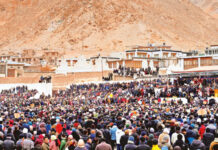Jyoti Sahi
Self-sufficiency is not simply about national identity. Creative art addresses relation of culture to its natural environment. Culture cannot grow through self-dependence alone
The first-ever comprehensive showcase of paintings that were commissioned by Mahatma Gandhi for what turned out to be a significant session of the Congress at Haripura in Gujarat in 1938 are now on display at the prestigious National Gallery of Modern Art, Bengaluru. The so-named ‘Haripura panels’, considered a national treasure, are the work of the Indian painter and teacher Nandalal Bose (1882-1966). The renewed interest and discussions occasioned by the exhibition bring up important questions on ideas of Swadeshi, nationalism and the role of cultural diversity in rediscovering our own roots. Visiting this exhibition, I have been struck by the political impact of the freedom struggle on the imagination of artists. The exhibition explores the nationalism of Bose, as well as the fact that he represents the source of a uniquely Indian modernism. Was the underlying impulse within the artistic genius of Bose just a return to the past, inspired by his youthful participation in the Swadeshi movement? Or is his art something quite new in the Indian tradition, and in that sense a sign of a modern vision in Indian culture? The relation of art to nationalism raises larger questions concerning the roots of modern Indian art. In the Indian context, nationalism, art and political imaginations are closely linked. Modern Indian art had its beginnings in the freedom struggle that broke free of the cultural dependency that drained away Indian creativity during the colonial period. The driving impulse behind this effort was to rediscover an authentic self-image, the identity that was called ‘Swadeshi’ or “of our own land”. ‘Swadeshi’ implies self-sufficiency, acknowledging that every community receives what is needed for life from its natural and cultural environment. In a way, this is a geographically determined concept of a given culture. Every authentic culture evolves out of a relationship between the human person and community, and the physical body of the land that provides a nurturing environment for a nation. However, ‘self-sufficiency’ is not simply about a national identity. Creative art addresses the relation of culture to its natural environment. Culture cannot grow through self-dependence alone. Growth arises from the interplay between different, though complementary, forces. The image of a tree represents the link between sky and earth. It symbolises the coming together of what is above, and what is below; what is seen, and what remains hidden. A seed, in order to sprout, needs both earth and water. A living plant grows naturally towards the light and warmth that comes from above the soil. Organic growth is the consequence of inner and outer energies working together.
In that sense, nothing is sufficient in itself, as every living process implies moving outwards, reaching towards what is the ‘other’. In the same way, a living culture responds to outer influences that enhance the potentiality within a local culture. The tree reminds us of the interconnectedness of every branch of life. The flowers and fruits of a tree represent a vitality that engages and interacts with, many other creatures that live beyond the individual tree. Nandalal Bose had been deeply affected by the study of Ajanta frescoes, influenced by his teacher Abanindranath Tagore (1871-1951). These murals incorporate scenes from everyday life, executed in the second century before our common era. These scenes have shaped the imagination of many artists through the millennia. However, though Indian art is profoundly indebted to this vision of life, it is not possible for artists today to repeat the art coming from some 22 centuries in the past. Though Bose encouraged his students to explore the everyday life in the countryside around Kala Bhavan in Santiniketan, that offered a source for their imaginative growth, he never insisted that students copy paste artistic styles. His own art was very much an approach to natural materials which he learnt from exchanging techniques with contemporary artists coming from China and Japan, who were attracted by the universal vision of the ‘Viswa Bharati’ experiment of Tagore. The series of ‘Haripura’ panels using natural art materials depicted the everyday life to be observed in village India. The themes painted with a simple directness, and spontaneous brush strokes, are unique in that they derive their strength from a synthesis of Indian and Far Eastern art traditions. As a student of Abanindranath Tagore, Bose was influenced by the Swadeshi movement which began in 1905 when Bose was in his early 20s. The Bengal School of Art style that tried to return to the achievements of Indian art in the past, reminds one of the spirits that infused the pre-Raphaelite revivalist art of England that reacted against the Industrial Revolution. John Ruskin (1819-1900) along with Edward Burne-Jones (1833-1898) and William Morris (1834-1896) developed a decorative approach to aesthetics, which they believed expressed the spirit of Gothic art. The problem of this romantic effort to go back in time to recover a lost pre-industrial culture in harmony with nature, was that it lacked a real engagement with the present and future of British culture. The Bengal School of Art, though preparing the ground for an Indian style, seems to lack the vigour and spontaneous energy which can be seen in the art of Bose. The work of Bose, like that of his contemporary, Jamini Roy, who also studied under Abanindranath Tagore, was a breakaway from an imitation of the past. These artists tried to find an Indian identity in a contemporary folk art. The way that the Haripura panels show the life of everyday village culture, is reminiscent of the art of Jean-Francois Millet (1814-1875) who broke from the historical themes of the Paris academic art of his day, rediscovering his native rural culture which he painted, celebrating everyday peasant life. This approach to the immediate present deeply influenced the art of Van Gogh.
A democratisation of art, drawing from folk culture that is in direct contact with the realities of those who live close to the cycles of nature, represents a modern outlook that draws inspiration from contemporary reality. Such an art, by being more accessible for those involved with today’s political concerns, has an energy that is the source of a socially engaged vision. It is in this sense that one can see in the art of Nandalal Bose what Ananda Coomaraswamy (1877-1947) termed a ‘true Swadeshi’, as opposed to the ‘false Swadeshi’ that draws from an imagined past. That is the significance of Nandlal Bose, and it carries deep messages for today’s social, cultural and political environment.
The Bengaluru exhibition was inaugurated last month and will remain open till April 2024.
(Jyoti Sahi is an artist, art teacher and runs an ashram in Bengaluru.)





























